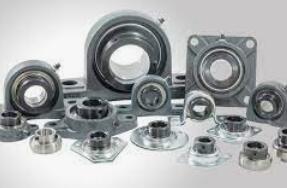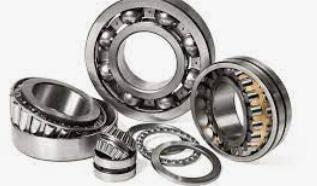Understanding Mounted Ball Bearings: Types, Advantages, Applications, and Maintenance
Learn about the types, advantages, applications, and maintenance of mounted ball bearings.
This guide will help you understand the benefits of using mounted ball bearings in machinery.
Mounted ball bearings are a crucial component of many types of machinery.
It's essential to understand the importance of using high-quality bearings to ensure smooth operation and minimize downtime.
In this guide, we'll explain the different types of mounted ball bearings, their advantages, applications, and maintenance.
|
Types of mounted ball bearings |
Advantages of mounted ball bearings |
Applications of mounted ball bearings |
Maintenance of mounted ball bearings |
|
Pillow block bearings |
High load capacity |
Conveyor systems |
Proper lubrication and inspection |
|
Flange mount bearings |
Self-aligning ability |
Agricultural machinery |
Addressing common issues such as misalignment and overloading
|
|
Take-up unit bearings |
Easy installation and maintenance |
HVAC systems |
|
The article can help you make informed decisions about your machinery.
Whether you're looking to improve performance, reduce downtime, or minimize maintenance costs, this guide will provide you with the information you need to get started.
Definition and explanation of mounted ball bearings

Mounted ball bearings are mechanical components used to support rotating shafts and reduce friction between moving parts in machinery.
A ball bearing consists of an inner and outer ring with a set of balls in between, which roll and rotate with low friction between the two rings.
The mounted ball bearings are designed with the ball bearings pre-installed into a housing, which can be bolted or secured to a stationary structure.
Mounted ball bearings are used in a wide range of applications, such as conveyor systems, food processing machinery, and agricultural equipment.
They can accommodate radial and axial loads, and are available in various sizes, materials, and designs to meet specific application requirements.
Proper installation and maintenance of mounted ball bearings are crucial for their performance and longevity.
Failure to do so can result in premature wear, increased vibration, and even catastrophic failure, leading to costly downtime and repairs.
Types of mounted ball bearings

Pillow block bearings:
Pillow block bearings, also known as plummer block bearings, are a type of mounted ball bearing that consists of a bearing and a housing.
The housing is shaped like a pillow or block, which provides support and protection for the bearing.
Pillow block bearings are commonly used in conveyor systems, agriculture equipment, and heavy-duty machinery.
Installation of a pillow block bearing involves mounting the housing onto a surface or frame, then inserting the bearing into the housing.
The advantages of pillow block bearings include their easy installation and maintenance, their ability to support heavy loads, and their suitability for harsh environments.
Pillow block bearings are an ideal choice when the shaft requires support at a fixed location, such as in conveyor systems or machines that require precise alignment.
Flange mount bearings:
Flange mount bearings are another type of mounted ball bearing that are designed with a flange, which is a flat plate with bolt holes that allows for easy mounting to a structure.
Flange mount bearings can support radial and axial loads and are commonly used in equipment such as motors, pumps, and fans.
One key feature of flange mount bearings is their ability to support radial loads, meaning loads that are perpendicular to the shaft, as well as axial loads, which are parallel to the shaft.
Flange mount bearings also have a compact design and are easy to install, making them a popular choice for machinery with limited space.
Compared to other types of bearings, flange mount bearings have a relatively low load capacity and are best suited for light to moderate loads.
Take-up unit bearings:
Take-up unit bearings are a unique type of mounted ball bearing that are used to accommodate shaft length changes due to thermal expansion or contraction, or belt tension adjustments.
They are commonly used in conveyor systems and other applications where shaft length changes are common.
The design of take-up unit bearings allows for the bearing to be moved within the housing, which compensates for changes in shaft length.
This is achieved through the use of a sliding or adjustable bearing mount.
Take-up unit bearings are often used in applications where there are long distances between fixed bearing supports, such as in conveyor systems or large machines.
One advantage of take-up unit bearings is their ability to reduce the risk of shaft damage due to thermal expansion or contraction, which can result in misalignment and premature bearing failure.
They are also easy to install and maintain, making them a popular choice for many industrial applications.
Characteristics and advantages of mounted ball bearings

Mounted ball bearings have several characteristics that make them a popular choice for supporting rotating shafts in machinery:
1.High load capacity: Mounted ball bearings are designed to support both radial and axial loads, making them ideal for heavy-duty applications.
They are capable of handling high loads without sacrificing performance or reliability.
2.Self-aligning ability: Mounted ball bearings are designed to be self-aligning, meaning they can compensate for slight misalignments in the shaft or housing.
This reduces the risk of premature wear and failure due to misalignment, which can save time and money on repairs and maintenance.
3.Easy installation and maintenance:Mounted ball bearings are designed for easy installation and maintenance.
They are typically pre-installed in a housing, which can be bolted or secured to a stationary structure.
This makes them easy to replace or remove for maintenance or repair purposes.
The advantages of mounted ball bearings include:
1.Improved performance and reliability: Mounted ball bearings provide improved performance and reliability compared to other types of bearings.
They are designed to handle high loads, reduce friction and wear, and compensate for misalignments, all of which contribute to improved overall performance and reliability.
2.Reduced downtime and maintenance costs: Mounted ball bearings are easy to install and maintain, which can reduce downtime and maintenance costs.
They can be quickly replaced or removed for maintenance or repair purposes, which can save time and money on repairs and maintenance.
3.Versatility and adaptability:Mounted ball bearings are available in a wide range of sizes, materials, and designs to meet specific application requirements.
This makes them versatile and adaptable to a wide range of applications, from conveyor systems to food processing machinery.
Applications of mounted ball bearings
Conveyor systems:
Mounted ball bearings are commonly used in conveyor systems to support and guide rotating shafts that move materials from one location to another.
Conveyor systems require bearings that can handle high loads, operate at high speeds, and reduce friction and wear to minimize downtime and maintenance costs.
Mounted ball bearings are ideal for conveyor systems because they can handle both radial and axial loads,
provide self-alignment to compensate for misalignments, and are easy to install and maintain.
They can also be designed with seals or shields to protect against contaminants and ensure long-lasting performance.
Agricultural machinery:
Mounted ball bearings are also commonly used in agricultural machinery such as tractors, harvesters, and irrigation systems.
Agricultural machinery requires bearings that can handle heavy loads, operate in harsh environments, and minimize downtime and maintenance costs.
Mounted ball bearings are ideal for agricultural machinery because they can handle high loads, reduce friction and wear,
and are designed with seals or shields to protect against dirt, dust, and other contaminants.
They are also easy to install and maintain, which can save time and money on repairs and maintenance.
HVAC systems:
Mounted ball bearings are also commonly used in HVAC (heating, ventilation, and air conditioning) systems to support and guide rotating shafts that drive fans, blowers, and pumps.
HVAC systems require bearings that can operate at high speeds, handle high loads, and minimize noise and vibration.
Mounted ball bearings are ideal for HVAC systems because they can handle high speeds, reduce friction and wear, and are designed to minimize noise and vibration.
They are also easy to install and maintain, which can save time and money on repairs and maintenance.
Maintenance and Troubleshooting Tips for Mounted Ball Bearings:
Lubrication and inspection:
Proper lubrication is crucial for the performance and longevity of mounted ball bearings.
The bearings should be lubricated according to the manufacturer's recommendations, using the appropriate lubricant and application method.
It is also important to inspect the bearings regularly for signs of wear or damage, such as noise, vibration, or excessive heat.
Common issues and solutions:
Common issues with mounted ball bearings include misalignment, overloading, contamination, and insufficient lubrication.
Misalignment can lead to premature wear and failure, while overloading can cause bearing damage or failure.
Contamination from dirt, dust, or other particles can also cause bearing damage, while insufficient lubrication can result in excessive friction and wear.
To troubleshoot these issues, it is important to inspect the bearings for signs of wear or damage and take corrective action as needed.
This may include realigning the shaft or housing, reducing the load on the bearing, cleaning or replacing contaminated bearings, or increasing lubrication.
In some cases, it may be necessary to replace the bearing entirely.
It is also important to follow proper installation procedures, such as ensuring proper alignment, torque, and clearance, to prevent issues from arising in the first place.
Conclusion:
Mounted ball bearings are a crucial component of many types of machinery, and understanding how to choose,
install, and maintain them can make a significant difference in the performance and reliability of your equipment.
By following proper maintenance procedures and addressing common issues,
you can ensure that your machinery runs smoothly and efficiently, saving you time and money in the long run





